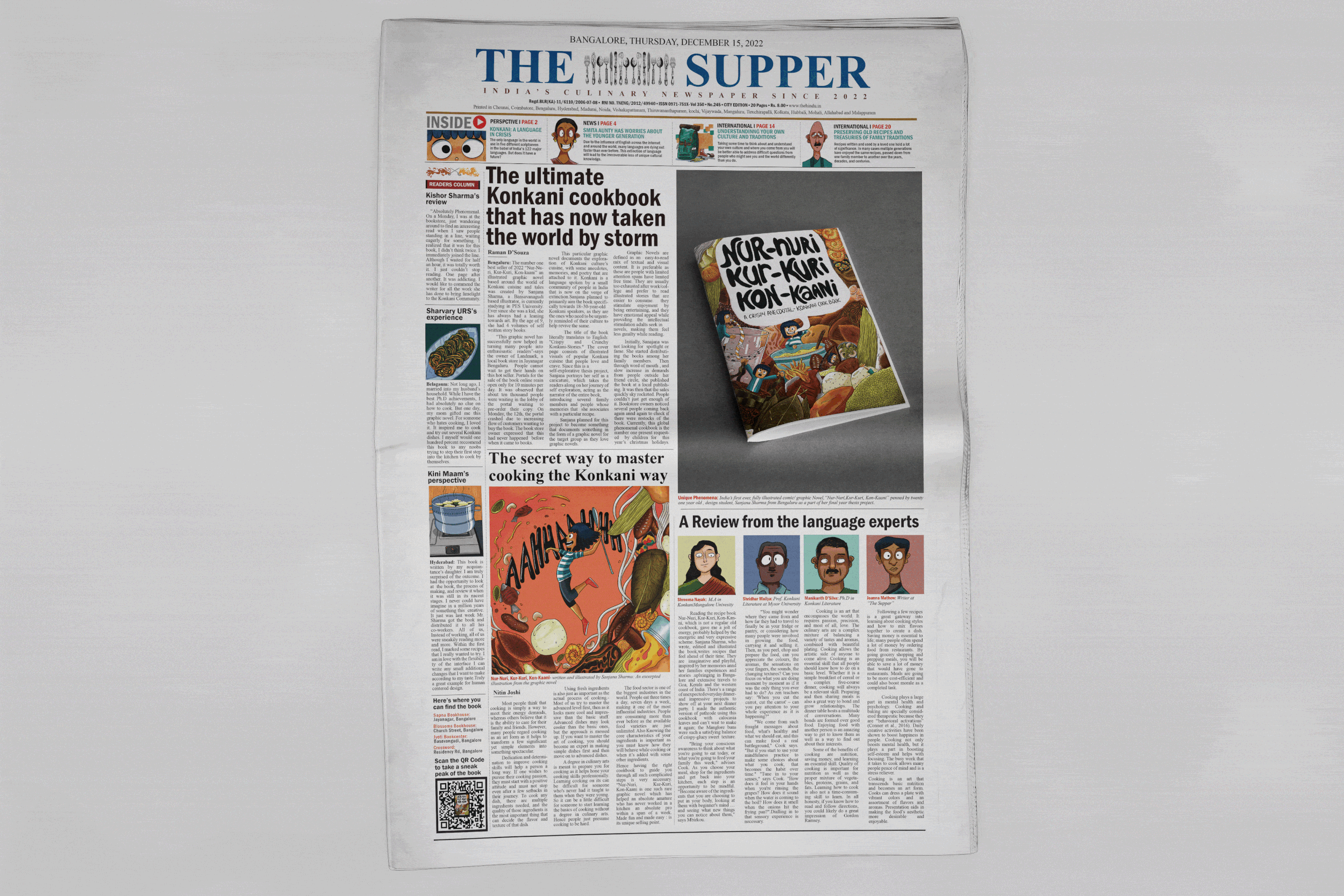NUR-NURI, KUR-KURI, KON-KAANI
Nur-Nuri, Kur-Kuri, Kon-Kaani is a graphic novel that tells Konkani folktales, poetry, and cuisine through the lens on my childhood growing up in a Konkani household.
Konkani is an Indo-Aryan language that typically spoken by the people on the western coast of India, also known as the Konkan coast. Various dialects of the language are spoken throughout the Konkan coast, which contains the traditions, lifestyles, and cultures that they follow. The language is spoken by 2.5 million people in India, where it is the official language of the state of Goa.
PROBLEM
In recent years, Konkani has been seen as a dying language among linguists and scholars in the field of Konkani. There has been an enormous loss of accumulated knowledge associated with the language. This is especially true due to an Enormous number of deaths the community is facing among its speakers, Records about the language are not well written down, as it doesn’t have a scripture of its own. In history, Konkani was written in Prakrit script, but the practice was lost. As a result, there hasn’t been proper documentation in the language itself and Globalization, leading to Westernized lifestyles.
PROBLEM STATEMENT
“To design an interface that effectively documents and presents information on Konkani folktales, poetry and cuisine for both Konkani and non-Konkani speakers within the age range of 18-30 years who are inquisitive, to spread awareness and give a voice to the Konkani speaking community. “
OBJECTIVES OF THE BOOK
The objectives are to explore and understand the most effective methods of documentation that resonate with the target demographic, considering their needs, preferences, and opinions on the subject. This involves assessing the perspectives of both Konkani-speaking and non-Konkani-speaking individuals regarding the culture and community, and evaluating the representation of this culture in mainstream media. Additionally, the aim is to collect diverse information on folktales, poetry, and recipes from people of various Konkani dialects, religions, and geographic regions, while also gathering personal memories and experiences from Konkani speakers. This exploration extends to examining my own family background and hometown, which serves as a foundation to delve into multiple facets of the culture.
RELATIONSHIP BETWEEN FOOD AND CULTURE
Food is so much more than something that is meant to sustain life. It speaks of class division, changing tastes, and regional and cultural differences. It signals a deep connection between history and culture. Food provides us with something more symbolic than simply a nourishing tool. It forms an important link to our culture and heritage.
SCOPE OF THE BOOK
This project is documented in the form of a graphic novel for the target group as they love graphic novels which are easy-to-read mix text and visual content. It is preferable as these are people with limited attention spans who have limited free time. They are usually too exhausted after work/college and prefer to read illustrated stories that are easier to consume. It primarily aims at educating the target group about the Konkani culture in aspects such as folk tales, literature, stories, poetries, songs, experiences, dramas, recipes, festivities and its method of celebration, differences between the different dialects and history of the culture.
TARGET AUDIENCE
The graphic novel is primarily targeted at individuals aged 18–30, as statistics from the website Graphic Policy indicate that this age group shows the highest interest in graphic novels. Within this range, those aged 22–25 demonstrate significant engagement, and the 38–41 age group shows 20% more interest compared to other demographics. Supporting this, data from Boopsie, a well-known graphic novel selling platform, reveal that 40% of their readers fall between 18 and 25 years, 5% are under 17, and 16% are between 26 and 33. Therefore, the primary target audience is youth aged 18–30, with a secondary focus on avid readers aged 15–17.
RESEARCH METHODS EMPLOYED
The research methods employed for developing the graphic novel include a combination of creative and scientific approaches. The creative research involves action research analysis, which is complemented by a scientific approach using historical research. Additional methods include a literature study to gather existing knowledge, a market study to understand current trends, and surveys and interviews to gain direct insights from the target audience.
ADVERTISING CAMPAIGN
Unlike traditional advertisements that stand out separately in newspapers, the idea of this ad campaign is to seamlessly integrate the advertisement within the newspaper’s content, giving the impression that the book is so highly regarded that the newspaper itself recommends it. Advertising in newspapers offers several advantages. It provides greater flexibility in presentation, is cost-effective with the lowest cost per reader, and engages readers effectively—research indicates that 8 out of 10 readers trust newspaper ads more than personal recommendations and are more likely to take action. Additionally, newspaper advertising reaches a broad audience, with readership in India growing to 450 million since 2018. It also generates a quick response by reaching readers when they are in a receptive and positive mindset. Furthermore, newspaper ads enable precise targeting by offering various options to reach specific audiences based on location, zoning areas, specific groups, or behavioral segments. This range of products in newspaper advertising effectively influences and engages the audience.




